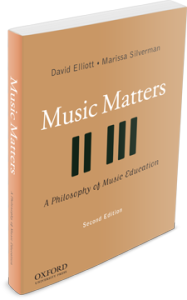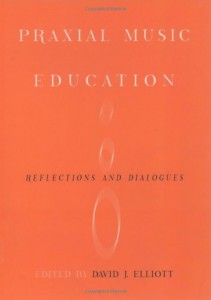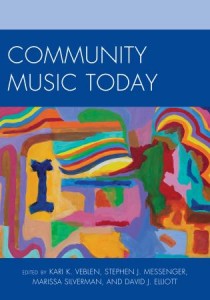Because the other sections of this web site address many aspects of the praxial curriculum, I will keep this section brief.
As Regelski explains (PME, chapter 12), the praxial philosophy posits a distinctive concept of curriculum for music teaching and learning. The idea is that all music education programs (general music programs and otherwise) ought to be organized and taught as reflective musical practicums. It is imperative to add, however, that the precise contents and details of each school (or community) music curriculum-as-practicum will differ according to local circumstances: that is, specific students and teachers in their own circumstances. I detail the foundations and nature of the curriculum-as-practicum in MM (chapters 10 and 11). I will not add more here. Suffice it to say that, in addition to Regelski’s enlightened chapter, the essays by Burnard, Dolloff, Martin, Barrett, and Woodward discuss many important details of the curriculum-as-practicum.
The central tenet of the practicum idea is holistic immersion. The aim is to develop all dimensions of students’ musicianship and listenership via students’ joyful, active engagements with all forms of musicing and listening. As I say:
“The praxial music curriculum is deliberately organized to engage learners in musical actions, transactions, and interactions with close approximations of real music-cultures. The praxial curriculum immerses students in music-making projects that require them to draw upon the standards, traditions, lore, landmark achievements, ‘languages,’ and creative strategies of the musical practices of which their projects are a part.”
From this perspective, the music teaching-learning environment is, itself, a key element in the music education enterprise. The musical actions of learners are enabled and promoted by the interactive, goal-directed “swirl” of questions, issues and knowings that develop around students’ efforts as reflective musical practitioners. The praxial curriculum is, itself, informative. (MM, p. 266)
Regelski agrees and adds that the need to “get back to the unique requirements of active music making as they exist in particular conditions of situatedness is, in fact, a defining trait of any praxial theory of music and, therefore, of a praxial orientation to curriculum for music education” (PME, p. 226). Although some critics believe the practicum is only concerned with teaching technical know-how via models and demonstrations (see PME, chapter 6), Regelski corrects this misunderstanding when he avers that the “learning by authentic doing” of praxis is “not mere techne” (p. 236). He continues: “The required ‘authenticity’ refers to real-life models of musical praxis, and ‘authentic evaluation’ of teaching and learning employs holistic assessment of the actual praxis adjusted for students’ developmental and age levels” (p. 236). Yes. I also agree with his statement, below, which I count as further support for the praxial view that music education must integrate musicing-and-listening:
“General music instruction, in particular, also needs its own practicum for listening. But this needs to include performing and compositional praxes of various kinds and degrees that inform listening in productive ways. But instead of having ‘just listening’ as the sole intended consequence of the general music curriculum, as is typically the case with MEAE, a praxial approach to general music class will also focus on developing an interest in and nurturing the skills for various kinds and levels of performing and creating music for recreational purposes.” (PME, p. 238)
Overall, then, I believe Regelski and I see eye-to-eye on almost everything. And where he voices concerns and/or suggests adjustments to my view, I feel sure I can accommodate these in the next edition of MM. For example, he is correct in saying that I should have paid more attention to so-called everyday musics, including “amateur, recreational, lay, and naïve” musics. Still, and for the sake of dialogue, I wonder whether many of these musics are actually well known practices (e.g., R&B) that Regelski is calling “amateur” or “lay” because they are largely absent from schools, or non-traditional (compared to “classical” practices), or “anti-establishment” in one way or another? In any event, because I’ve spent a considerable amount of time in the theoretical and practical worlds of community music during the last decade, I have a much better handle on why and how various kinds of amateur, lay, and recreational musicing should be incorporated into the school music curriculum-as-practicum (see, also, PME, chapter 17).
The last point I want to discuss is Regelski’s idea that school music instruction should not be too specialized at first. Instead, and because of the nature of schooling, he argues that we should focus on “shared, common or general musicianship abilities that, at functional entry levels will, for most students, become more ‘precise’ as they are employed and developed in context-dependent situations” (PME, pp. 236-237). He holds that “musicianship is most pragmatic that amounts to general musicianship [italics added]” by which he means “basic yet flexible or adaptable skills and concepts that can be further honed by the unique requirements of a specific praxis” (p. 236).
But if students enter school with a basic, shared, and/or “common” musicianship-listenership, isn’t this the same as saying that children already possess a specific, context-dependent form of musicianship? For example, Puerto Rican children in San Juan enter school with their “local” musics in their heads, whereas many inner-city Asian children in Toronto enter school with a socially-culturally different kind of musicianship. So, for example, to “unpack” what children bring to school in favor of instilling one kind of “general musicianship” seems to contradict some of the most basic tenets of praxial music and music education.
Indeed, is there such a thing as “general musicianship”? (Analogously, is there something called “general language-ship” that every child could learn before they specialize in “their language”?) And what does Regelski mean by “adaptable skills”? Does this mean aural acuity in the Western tonal-rhythmic tradition, and/or sight-reading skills?
I raise these questions only to highlight the possibility that “general musicianship” seems to move us backward to the old view of “music” as a universal, undifferentiated phenomenon and, therefore, away from the praxial natures and values of music-as-musical-practices that are deeply embedded in and reflective of their social-cultural communities (which Bowman and Regelski explain so well in PME).



